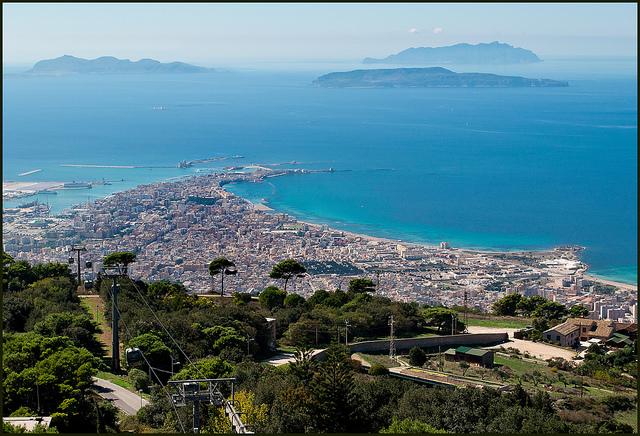Vacationers will find great diversity on
Italy’s largest island. Sicily is home to breathtakingly beautiful landscapes, superb beaches and proud architecture dating back to Greek antiquity. The island, situated south of the Italian
boot, is mountainous and marked by volcanic activity. The imposing volcanic cone of
Mount Etna is widely known as a major landmark of Sicily. The metropolis of Palermo offers visitors a restored historic Old Town. In the Cathedral on the Quattro Canti, visitors can admire historic royal tombs. The Boulevard of Foro Umberto I features a magnificent view of the Gulf of Palermo. In Catania the streets are lined with fine baroque buildings. A popular meeting point in the center of town is the black lava Elephant Fountain which graces the Piazza del Duomo. Anyone who visits Catania can find the grave of Vincenzo Bellini, the city’s most renowned native son, in the Duomo.
Located on the eastern coast of Sicily at the foot of Mount Etna is the town of Taormina. Impressive classical concerts are held in the ancient theater. Sicily is also greatly beloved by watersport enthusiasts. Isola Bella is valid as the nicest beach of the island. In the spring and fall, Sicily is also a popular destination for hikers. The varied landscape offers possibilities for treks at all levels of difficulty. One of the most beautiful hiking routes on Sicily leads to Monte Tauro, topped by a Saracen castle. Following a coastal road, one can reach the Punta del Faro, the northeastern promontory of Sicily.
Etna
The highest and most active volcano in Europe is Etna. Due to frequent eruptions and the resulting lava flows, the land surrounding the volcano is especially fertile. One can ascend the mountain on well-built roads by bus, on foot or in a cable car. However, one should always prepare very carefully for a mountain tour, especially in the winter months. Accompanied by a guide, one can take a hiking tour on Mount Etna and thereby learn much valuable information about the volcano’s natural phenomena.
Stromboli
The volcanic island of Stromboli is one of the eight Aeolian Islands, and is located north of Sicily in the Mediterranean Sea. Most of the island is covered by the volcano. However, there are also two small villages with a total of about 500 residents. Boats ferry tourists to the island from cities such as Messina, Melazzo and Naples. In the peak vacation season, additional hydrofoils are also operated. Whoever wishes to climb Mount Stromboli should be physically fit, as the pace is sometimes quite brisk and demanding. Above an altitude of 400 meters, a mountain guide must accompany the party.
Alcantara Gorge
The fascinating gorge of Alcantara can be visited between Taormina and Randazzo. Cut deep in volcanic rocks and cliffs, the gorge is in places as much as 20 meters deep and up to five meters wide. Scientific studies suggest that it was not created through erosion by the eponymous river, but instead resulted from an earthquake. Here one can enjoy the wonderful area and take a look at the impressing natural phenomenon of almost perfect hexagonal prisms of rocks, which were formed by the rapid cooling of lava. Only from May until September can visitors use the beach around the gorge. The water is frigid even in the summer months, so that one should always be cautious here.
Valley of the Temples
The quite well-preserved archeological sites of Agrigento on the southern coast of Sicily are known by the name “Valley of the Temples.” Here we find the remains of the Polis Akragas, an ancient Greek city, which was already founded in 582 BC. On his famous Italian Journey, the great German poet Goethe also visited the site, now listed by UNESCO as part of the World Cultural Heritage. The Valley of the Temples, despite its misleading name, is actually situated on a high plateau. Especially worth seeing is the Temple of Concordia, dating from the 5th century BC, which is still in remarkably good condition.
Aeolian Islands
The Aeolian Islands are of volcanic origin and are listed as a UNSECO World Heritage natural site. The islands’ residents now earn their living chiefly from agriculture, viticulture and tourism. Visitors can best get from one island to another by boat. In the summer months, each island boasts of its own unique festival. Thus, for example, there is the Caper Festival on Salina or a music and theater festival on Lipari. On the islands of Stromboli and Vulcano, there still are active volcanos, so that many vacationers hike in the mountains hoping to get a closer view of the spectacle.
Cathedral of Palermo
The Cathedral of Palermo was built in the years 1184 to 1185. The former German Hohenstaufen Emperors Friedrich II and Heinrich VI found their final resting places here. The Cathedral was constructed in Norman style, but underwent numerous alterations over the centuries. The external appearance is marked by a variety of Arab influences. One should also take a look at the Treasure Chamber to the right of the Chapel of Saint Rosalia. Here liturgical vestments and the splendid crown of Constance of Aragon are on display.
Cathedral of Monreale
Located directly on Monte Reale, the royal mountain, is the Cathedral of Monreale, a tourist magnet near Palermo. It is the largest church on the island. Both the interior and the façade display Norman and Arab architectural influences. One should by all means take time to admire the beautiful gold mosaics, which cover an impressive area of 6340 m². They depict various scenes from the Life of Jesus. The beautiful cloister on the south side was built at the same time as the Cathedral and goes back to a former Benedictine Cloister; it stretches 47 by 47 meters.

